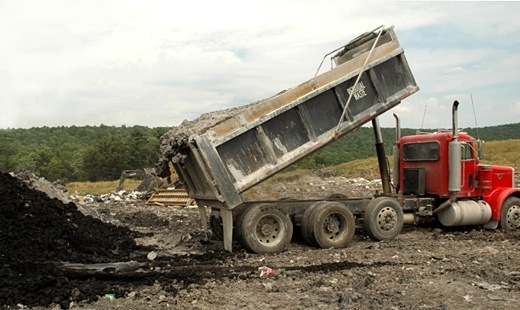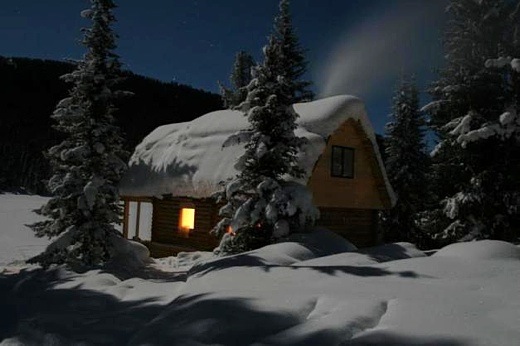SUBHEAD: As oil prices collapse, North Dakota considers weakening standards on radioactive drilling waste.
By Sharon Kelly on 25 February 2015 for DeSmogBlog -
(http://www.desmogblog.com/2015/02/25/oil-prices-collapse-north-dakota-considers-weakening-standards-radioactive-drilling-waste)

Image above: PA truck dumps what is labeled "Residual Waste" in NY. Tens of thousands of tons of radioactive drilling waste from Pennsylvania fracking sites are brought to into NY landfills, threatening public health and water quality. From (https://secure.sierraclub.org/site/Advocacy;jsessionid=73E58632AF0F8CF5A338C86053EB9F9E.app207a).
As the collapse of oil prices threatens North Dakota's shale drilling rush, state regulators are considering a move they say could save the oil industry millions of dollars: weakening the state's laws on disposing of radioactive waste.
The move has been the subject of an intensive lobbying effort by drillers, who produce up to 75 tons per day of waste currently considered too hazardous to dispose of in the state.
For every truckload of that waste, drillers could save at least $10,000 in hauling costs, they argue.
State regulators calculate that by raising the radioactive waste threshold ten-fold, the industry would shave off roughly $120 million in costs per year.
But many who live in the area say they fear the long-term consequences of loosened disposal rules combined with the state's poor track record on preventing illegal dumping.
“We don't want to have when this oil and coal is gone, to be nothing left here, a wasteland, and I'm afraid that's what might happen,” farmer Gene Wirtz of Underwood, ND told KNX News, a local TV station. “Any amount of radiation beyond what you're already getting is not a good thing.”
Environmental groups have also objected that the rule change would put private companies' profits before public health.
“The only reason we're doing this today is to cut the oil industry's costs,” Darrell Dorgan, spokesman for the North Dakota Energy Industry Waste Coalition, which opposes the move, told Reuters.
There is no question that the industry is under severe financial pressure. The same barrel of Bakken crude oil that sold for $136.29 in July 2008 was priced at $34.50 this month, putting drillers, many of whom carry high levels of debt, into a financial bind.
To make debt payments, companies need to drill and frack new wells, since shale wells deliver much of their oil in a fast burst immediately following drilling, oil industry analysts say. With prices well below the breakeven point for many operators in the state's shale field, the industry's desire to cut costs is intense.
State regulators across the U.S. are feeling the pain as well, concerned about lower revenue not only from extraction taxes, but also lost jobs and plunging property values. Although North Dakota officials predict relatively minor harm to the state's general fund, planned infrastructure improvements and road repairs might be put on hold, The New York Times reported in December.
But along with revenue from shale oil and gas, the drilling rush has brought an unprecedented amount of low-level radioactive waste to the US, fueling debates in many states about how to handle the waste in the absence of federal rules.
In North Dakota, the shale rush has already produced tens of thousands of tons of low-level radioactive waste laced with radium and uranium, including up to 169 million oil filter socks where radioactivity tends to be more heavily concentrated, per year.
“We have many more wells, producing at an accelerating rate, and for each of them there’s a higher volume of waste,” Avner Vengosh, a professor of geochemistry at Duke University in Durham, North Carolina, told Bloomberg in 2014. Unless it is well managed, he added, “we are actually building up a legacy of radioactivity in hundreds of points where people have had leaks or spills around the country.”
Under North Dakota law, drillers cannot currently dispose of waste carrying more than 5 picocuries per gram (pci/g) of radioactivity – roughly the amount found in much of the soil in the state. The proposed 50 pci/g cap, while far below the highest in the country, would make North Dakota one of the least strict states in the region.
State regulators say the higher cap would still protect human health and safety, basing their proposed new rules on a report by Argonne National Laboratory that recommended steps, included in the state's proposed rules, to protect against potential harm to workers handling the waste, including a 25,000 ton limit per licensed landfill per year and a requirement that the waste be buried at least 10 feet below ground.
To be sure, it would be far less hazardous for the radioactive waste to wind up in landfills that have better liners and controls for leachate run-off and groundwater monitoring than dumped illegally.
But some living nearby argue that adding any more radioactivity to their communities is too much.
“The Argonne Report is based on 25,000 tons per year of oilfield waste in a single landfill containing the higher levels of radioactive waste. Based on this, the study estimates people living within a 50-mile radius of a new 25,000-ton radioactive dump may be exposed to twice the normal amount of radiation,” wrote Theodora Bird Bear, chair of Dakota Resource Council. “This means our trade-off is more childhood leukemia, illness and death.”
Other advocates are skeptical that the limits in the new rules will be adequately enforced if they are adopted.
“If this administration hasn't been 'able to track low levels of radioactive and toxic waste… why would we trust them with more responsibility' on this issue,” Don Morrison, executive director of the North Dakota Resource Council, told Inside Climate News in December.
Currently, much of the waste is shipped to landfills in states like Idaho, Utah or Montana. But North Dakota regulators have no clear mechanism for tracking the waste, making illegal dumping tempting for some in the industry. In one high-profile case, an abandoned gas station was filled with roughly 200 trashbags stuffed with radioactive waste.
A 2014 Associated Press investigation found that in the span of one year, over 150 people attempted to illegally dump radioactive waste at local landfills – and state regulators never issued fines or sanctions, simply asked for a promise to lawfully dispose of the waste.
Some operators are not disposing of the waste at all. “There are operators out there who are stockpiling the stuff because either they don’t know what to do with the waste or it’s too expensive,” said Erickson, owner of Plains Energy Technical Resources. In response, state regulators issued regulations requiring drillers to store radioactive waste in leak-proof containers to prevent run-off.
Under the state's proposed new rules, 10 landfills in the state would be qualified to accept radioactive oil and gas waste, but many more have applied for approval, state regulators told Inside Climate News. The lack of federal regulations for hazardous waste from oil and gas sites has meant that state can individually set their own standards and enforcement mechanisms, and rules vary widely.
“At the federal level, radioactive oil and gas waste is exempt from nearly all the regulatory processes the general public might expect would govern it,” Environmental Health Perspectives reported last year. “State laws are a patchwork.’”
Some states already allow municipal landfills to accept waste with radioactivity as high as North Dakota's proposed limits for industrial waste landfills.
But the sheer quantity of the waste from the shale rush gives the issue new dimensions – both in terms of the potential harm from contaminated water sources and airborne dust and the costs of disposal.
The radioactive material from shale drilling naturally lies buried in the same rock formations that drillers target, and is brought to the surface both in the wastewater from drilling and fracking, and in rock fragments called cuttings. The alpha radioactivity generally associated with drilling waste cannot penetrate skin, and is only harmful if people drink water or breathe air containing the materials.
However, the radioactive materials can accumulate in trucks and pipelines, leaving regulators concerned about possible exposure threats to workers if the waste is carelessly handed.
The oil industry argues that North Dakota's current rules for handling the waste are simply too costly.
“You're talking hundreds of dollars to transport versus tens of thousands” of dollars under North Dakota's proposed looser standards, Kari Cutting, vice president of the North Dakota Petroleum Council told Reuters, adding that she had attended several public hearings on the topic. “This just shows how much of a priority we're putting on this and these costs.”
Some in the region find that logic unconvincing.
“When the Bakken oil boom started, the oil industry knew they were going to produce radioactive waste and they knew what they were required to do with it. But, they didn’t put that into their business plans,” wrote Ms. Bird Bear. “The process to increase the allowable level of radioactivity in our state began about two years ago with behind-closed-door meetings with the health department and the oil industry. The result is once again a green light to the oil industry, this time to dump more radioactive waste in our state.”
Public comment on the proposal has been extended until March 2.
.
By Sharon Kelly on 25 February 2015 for DeSmogBlog -
(http://www.desmogblog.com/2015/02/25/oil-prices-collapse-north-dakota-considers-weakening-standards-radioactive-drilling-waste)

Image above: PA truck dumps what is labeled "Residual Waste" in NY. Tens of thousands of tons of radioactive drilling waste from Pennsylvania fracking sites are brought to into NY landfills, threatening public health and water quality. From (https://secure.sierraclub.org/site/Advocacy;jsessionid=73E58632AF0F8CF5A338C86053EB9F9E.app207a).
As the collapse of oil prices threatens North Dakota's shale drilling rush, state regulators are considering a move they say could save the oil industry millions of dollars: weakening the state's laws on disposing of radioactive waste.
The move has been the subject of an intensive lobbying effort by drillers, who produce up to 75 tons per day of waste currently considered too hazardous to dispose of in the state.
For every truckload of that waste, drillers could save at least $10,000 in hauling costs, they argue.
State regulators calculate that by raising the radioactive waste threshold ten-fold, the industry would shave off roughly $120 million in costs per year.
But many who live in the area say they fear the long-term consequences of loosened disposal rules combined with the state's poor track record on preventing illegal dumping.
“We don't want to have when this oil and coal is gone, to be nothing left here, a wasteland, and I'm afraid that's what might happen,” farmer Gene Wirtz of Underwood, ND told KNX News, a local TV station. “Any amount of radiation beyond what you're already getting is not a good thing.”
Environmental groups have also objected that the rule change would put private companies' profits before public health.
“The only reason we're doing this today is to cut the oil industry's costs,” Darrell Dorgan, spokesman for the North Dakota Energy Industry Waste Coalition, which opposes the move, told Reuters.
There is no question that the industry is under severe financial pressure. The same barrel of Bakken crude oil that sold for $136.29 in July 2008 was priced at $34.50 this month, putting drillers, many of whom carry high levels of debt, into a financial bind.
To make debt payments, companies need to drill and frack new wells, since shale wells deliver much of their oil in a fast burst immediately following drilling, oil industry analysts say. With prices well below the breakeven point for many operators in the state's shale field, the industry's desire to cut costs is intense.
State regulators across the U.S. are feeling the pain as well, concerned about lower revenue not only from extraction taxes, but also lost jobs and plunging property values. Although North Dakota officials predict relatively minor harm to the state's general fund, planned infrastructure improvements and road repairs might be put on hold, The New York Times reported in December.
But along with revenue from shale oil and gas, the drilling rush has brought an unprecedented amount of low-level radioactive waste to the US, fueling debates in many states about how to handle the waste in the absence of federal rules.
In North Dakota, the shale rush has already produced tens of thousands of tons of low-level radioactive waste laced with radium and uranium, including up to 169 million oil filter socks where radioactivity tends to be more heavily concentrated, per year.
“We have many more wells, producing at an accelerating rate, and for each of them there’s a higher volume of waste,” Avner Vengosh, a professor of geochemistry at Duke University in Durham, North Carolina, told Bloomberg in 2014. Unless it is well managed, he added, “we are actually building up a legacy of radioactivity in hundreds of points where people have had leaks or spills around the country.”
Under North Dakota law, drillers cannot currently dispose of waste carrying more than 5 picocuries per gram (pci/g) of radioactivity – roughly the amount found in much of the soil in the state. The proposed 50 pci/g cap, while far below the highest in the country, would make North Dakota one of the least strict states in the region.
State regulators say the higher cap would still protect human health and safety, basing their proposed new rules on a report by Argonne National Laboratory that recommended steps, included in the state's proposed rules, to protect against potential harm to workers handling the waste, including a 25,000 ton limit per licensed landfill per year and a requirement that the waste be buried at least 10 feet below ground.
To be sure, it would be far less hazardous for the radioactive waste to wind up in landfills that have better liners and controls for leachate run-off and groundwater monitoring than dumped illegally.
But some living nearby argue that adding any more radioactivity to their communities is too much.
“The Argonne Report is based on 25,000 tons per year of oilfield waste in a single landfill containing the higher levels of radioactive waste. Based on this, the study estimates people living within a 50-mile radius of a new 25,000-ton radioactive dump may be exposed to twice the normal amount of radiation,” wrote Theodora Bird Bear, chair of Dakota Resource Council. “This means our trade-off is more childhood leukemia, illness and death.”
Other advocates are skeptical that the limits in the new rules will be adequately enforced if they are adopted.
“If this administration hasn't been 'able to track low levels of radioactive and toxic waste… why would we trust them with more responsibility' on this issue,” Don Morrison, executive director of the North Dakota Resource Council, told Inside Climate News in December.
Currently, much of the waste is shipped to landfills in states like Idaho, Utah or Montana. But North Dakota regulators have no clear mechanism for tracking the waste, making illegal dumping tempting for some in the industry. In one high-profile case, an abandoned gas station was filled with roughly 200 trashbags stuffed with radioactive waste.
A 2014 Associated Press investigation found that in the span of one year, over 150 people attempted to illegally dump radioactive waste at local landfills – and state regulators never issued fines or sanctions, simply asked for a promise to lawfully dispose of the waste.
Some operators are not disposing of the waste at all. “There are operators out there who are stockpiling the stuff because either they don’t know what to do with the waste or it’s too expensive,” said Erickson, owner of Plains Energy Technical Resources. In response, state regulators issued regulations requiring drillers to store radioactive waste in leak-proof containers to prevent run-off.
Under the state's proposed new rules, 10 landfills in the state would be qualified to accept radioactive oil and gas waste, but many more have applied for approval, state regulators told Inside Climate News. The lack of federal regulations for hazardous waste from oil and gas sites has meant that state can individually set their own standards and enforcement mechanisms, and rules vary widely.
“At the federal level, radioactive oil and gas waste is exempt from nearly all the regulatory processes the general public might expect would govern it,” Environmental Health Perspectives reported last year. “State laws are a patchwork.’”
Some states already allow municipal landfills to accept waste with radioactivity as high as North Dakota's proposed limits for industrial waste landfills.
But the sheer quantity of the waste from the shale rush gives the issue new dimensions – both in terms of the potential harm from contaminated water sources and airborne dust and the costs of disposal.
The radioactive material from shale drilling naturally lies buried in the same rock formations that drillers target, and is brought to the surface both in the wastewater from drilling and fracking, and in rock fragments called cuttings. The alpha radioactivity generally associated with drilling waste cannot penetrate skin, and is only harmful if people drink water or breathe air containing the materials.
However, the radioactive materials can accumulate in trucks and pipelines, leaving regulators concerned about possible exposure threats to workers if the waste is carelessly handed.
The oil industry argues that North Dakota's current rules for handling the waste are simply too costly.
“You're talking hundreds of dollars to transport versus tens of thousands” of dollars under North Dakota's proposed looser standards, Kari Cutting, vice president of the North Dakota Petroleum Council told Reuters, adding that she had attended several public hearings on the topic. “This just shows how much of a priority we're putting on this and these costs.”
Some in the region find that logic unconvincing.
“When the Bakken oil boom started, the oil industry knew they were going to produce radioactive waste and they knew what they were required to do with it. But, they didn’t put that into their business plans,” wrote Ms. Bird Bear. “The process to increase the allowable level of radioactivity in our state began about two years ago with behind-closed-door meetings with the health department and the oil industry. The result is once again a green light to the oil industry, this time to dump more radioactive waste in our state.”
Public comment on the proposal has been extended until March 2.
.








